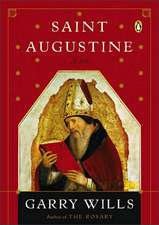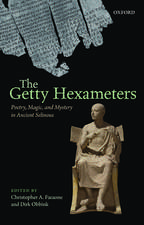Font of Life: Emblems of Antiquity
Autor Garry Willsen Limba Engleză Hardback – 31 mar 2012
| Toate formatele și edițiile | Preț | Express |
|---|---|---|
| Hardback (2) | 103.08 lei 41-52 zile | |
| Oxford University Press – 31 mar 2012 | 133.00 lei 3-5 săpt. | |
| Oxford University Press – 11 apr 2012 | 103.08 lei 41-52 zile |
Preț: 133.00 lei
Nou
Puncte Express: 200
Preț estimativ în valută:
25.45€ • 26.37$ • 21.24£
25.45€ • 26.37$ • 21.24£
Carte disponibilă
Livrare economică 01-15 martie
Preluare comenzi: 021 569.72.76
Specificații
ISBN-13: 9780199768516
ISBN-10: 019976851X
Pagini: 208
Dimensiuni: 145 x 213 x 23 mm
Greutate: 0.32 kg
Editura: Oxford University Press
Seria Emblems of Antiquity
ISBN-10: 019976851X
Pagini: 208
Dimensiuni: 145 x 213 x 23 mm
Greutate: 0.32 kg
Editura: Oxford University Press
Seria Emblems of Antiquity
Notă biografică
Descriere
Descriere de la o altă ediție sau format:
One of the most important religious sites in the world is largely hidden and rarely visited. It lies under the piazza in front of Milan's cathedral, and was uncovered by archaeologists only after World War II. It is part of the foundations of a fourth century cathedral from the time of Bishop Ambrose, the most powerful figure in the Christian West during Late Antiquity. To reach it, one must go inside the huge later cathedral and find a stairway by its westernwall. After descending narrow stairs one reaches an eight-sided pool (piscine) that was used for total-immersion baptisms by Ambrose. There at dawn on Easter of 387, a cluster of people seeking baptism had gathered after an all-night vigil. Among those seeking baptism was Augustine, an African who had served as the imperial orator at the Milan court of the Emperor. Augustine would go back to his native Africa to become the bishop of Hippo and the most influential writer of the Christian West during the whole later course of the Middle Ages. Alongside him stood his son, his mother, his brother, and two of his pupils andacademic colleagues. Nothing less than the future of the Western church was being formed in this cluster of talent and devotion. Font of Life tells the story of this crucial event in the history of the Church. Beginning with the archaeology of Ambrose's Milan and the discovery of the baptistery, Garry Wills tells the story of the at times prickly relationship between Ambrose and Augustine and its importance for the future history of the Church, illuminating the scene of the baptism itself, along with the sources of its ritual, and introducing us to the company of the relatives and friends who greeted Augustineas he emerged from the pool. Appropriately, the book ends with a reflection on the later relationship between Augustine and Ambrose and the influence of the latter upon Augustine's later thought - which has been so seminal in the development of Christian thought ever since.
One of the most important religious sites in the world is largely hidden and rarely visited. It lies under the piazza in front of Milan's cathedral, and was uncovered by archaeologists only after World War II. It is part of the foundations of a fourth century cathedral from the time of Bishop Ambrose, the most powerful figure in the Christian West during Late Antiquity. To reach it, one must go inside the huge later cathedral and find a stairway by its westernwall. After descending narrow stairs one reaches an eight-sided pool (piscine) that was used for total-immersion baptisms by Ambrose. There at dawn on Easter of 387, a cluster of people seeking baptism had gathered after an all-night vigil. Among those seeking baptism was Augustine, an African who had served as the imperial orator at the Milan court of the Emperor. Augustine would go back to his native Africa to become the bishop of Hippo and the most influential writer of the Christian West during the whole later course of the Middle Ages. Alongside him stood his son, his mother, his brother, and two of his pupils andacademic colleagues. Nothing less than the future of the Western church was being formed in this cluster of talent and devotion. Font of Life tells the story of this crucial event in the history of the Church. Beginning with the archaeology of Ambrose's Milan and the discovery of the baptistery, Garry Wills tells the story of the at times prickly relationship between Ambrose and Augustine and its importance for the future history of the Church, illuminating the scene of the baptism itself, along with the sources of its ritual, and introducing us to the company of the relatives and friends who greeted Augustineas he emerged from the pool. Appropriately, the book ends with a reflection on the later relationship between Augustine and Ambrose and the influence of the latter upon Augustine's later thought - which has been so seminal in the development of Christian thought ever since.
Recenzii
This short book is a most original study of [a] momentous occasion.
When Garry Wills is not hectoring some central truths of Catholicism, he oftentimes proves one of its best historians, and this latest is a fine example thereof. ... Wills does a first-rate job ... and, as such, this work could easily find a home in any university course on the Fathers, on baptism, or in the hands of any schoalr interested in Latin Christianity's concerns and ecclesial practices at the turn of the fifth century.
When Garry Wills is not hectoring some central truths of Catholicism, he oftentimes proves one of its best historians, and this latest is a fine example thereof. ... Wills does a first-rate job ... and, as such, this work could easily find a home in any university course on the Fathers, on baptism, or in the hands of any schoalr interested in Latin Christianity's concerns and ecclesial practices at the turn of the fifth century.


















